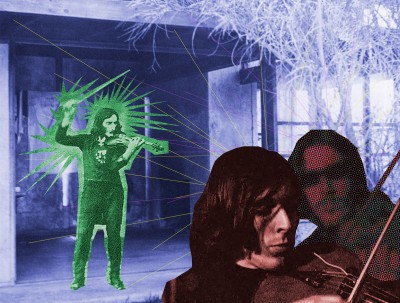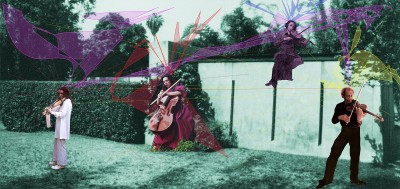The year 2012 was the centennial anniversary of the birth of composer John Cage, a former resident of the Schindler House on Kings Road. In the mid-1930s, during his years of musical study and apprenticeship and around the time when he began studies with Arnold Schoenberg, Cage commented that the Schindler House was “clearly a ‘modern’ house, but…an extraordinary house, particularly in its details…. All the details of nature are present.” He admired the interaction of the inside and outside of the house. He mentioned that its “music…is matched by a sense of humanity.”1
How much the house had an effect on Cage directly or indirectly, and whether he stayed there “a little less than a year”2 or just nine days, is difficult to pin down. Regardless, both Cage and R.M. Schindler were radical purveyors of culture in Los Angeles, and eventually the rest of the world. Alongside each of them was the equally radical Pauline Schindler, or S.P.G.
The overlapping of professional and personal trajectories of these figures may be footnotes but I wish to consider a true collaboration among them in the spirit of those times, the spirit of the house, and the spirit of their creative qualities. I want to explore the infusion of R.M. Schindler’s architectural masterpiece with the social and intellectual qualities of Pauline Schindler and conceptual experimentation of composer John Cage. In keeping with Cage’s feelings about the house, S.P.G.’s social and cultural projects, and Schindler’s ideas of space, climate, light, and mood, this project will bring Cage’s music into the Schindler House. The project will recreate the original social dynamic of the Schindler House through music, by hosting a string quartet playing Cage compositions in different rooms. The idea draws from the original conception of a string quartet as “four rational people conversing”3 or as “music of friends.”4

Film and Musical Performance
The project includes two parts: a film installation and a musical performance. The first is a series of two short films to be projected on screens in two separate rooms of the Schindler House. The length of each film will be 5 to 20 minutes. If space is limited, it could be shown in one room with one screen, not to exceed 30 minutes.
The films will be experimental in nature, a fusion of experimental documentary and film abstraction. They will document many architectural aspects of the Schindler House, such as the redwood structures and beams, cement walls and floors, glass slats, copper fireplaces, clerestory windows, Insulite panels, sunken gardens and patios, the surrounding greenery, and walkways. The films will focus on Schindler’s devotion to natural colors and materials and capture how light enters the house through various apertures. The films will follow the geometric patterns of light and shadow in conjunction with the structural lines of the building. In addition to documenting the House itself, the films will also document the Cage string quartet, as a visual and sonic presence interacting with the house.
The musicians will play Cage compositions written specifically for string quartet. The performance will modulate between a straightforward note-for-note manner and an experimental, interpretative approach. These variations will serve to “open up the Cage” and allow the musicians to use the architectural structure of the Schindler House as musical score.5 This approach to Cage’s work is akin to opening up the walls of the house, breaking down the barriers of interior and exterior.
The physical properties of the Schindler House will affect the auditory quality of the films and musical performance. The project will utilize the echoes and sounds made from inside the house, as music bounces off the cement walls and floor, redwood beams, Insulite panels, glass windows, and low ceilings, as well as the ambient sounds of the outside environment, such as swaying foliage or car sounds. The visual rhythm of the films will be determined by the recorded music of the Cage string quartets, which was influenced by the architectural qualities of the house itself.
The second aspect of this project is a live musical performance of the Cage String Quartet compositions during the opening of the exhibition. This is in keeping with the history of the Schindler House and with the Cagean belief of the importance of musical performance over recording.

The performance will utilize the practices of a musical happening, rather than a traditional string performance. The quartet will begin in the Chace courtyard in a traditional manner, then disband to move separately into the house, using different materials and objects found there. The musicians will have the option to wander about independently, to reposition themselves to alter the sound of the music (within reasonable limits considering safety and the preservation of the house). This will allow another opportunity to make use of the house as a musical score. The musicians will eventually have the option to reconvene. This will be the socially engaged aspect of the performance, acting as a true melding of radical minds. The musical performance would not exceed 20 minutes.
Music
The John Cage compositions to be played and improvised on:
String Quartet in Four Parts (1949–50)
Music for Four (1987, revised 1988)
Thirty Pieces for String Quartet (1983)
Four (1989)
Players
Jessica Catron – Cello
Andrew Tholl – Violin
Melinda Rice – Violin
Andrew MacIntosh – Viola
These players and fellow collaborators are CalArts-based and have considerable experience, talent, and knowledge of John Cage compositions.
1 Majorie Perloff and Charles Junkerman, John Cage: Composed in America (Chicago: University of Chicago Press, 1994), p. 85.
2 Ibid.
3 This is Johann Wolfgang von Goethe’s description of chamber music, in particular quartet music. Christina Bashford, “The String Quartet and Society,” in The Cambridge Companion to the String Quartet, ed. Robin Stowell (Cambridge: Cambridge University Press, 2003), p. 4. The quote was from a letter to C.F. Zelter, November 9, 1829.
4 Richard Walthew, 1909, public lecture, quoted in Bashford, p. 4.
5 This would be a play on the traditional idea-making variations in classical and avant-garde music, as well as a play on Cage’s Variations, which were a series of pieces using indeterminate music and happenings. The scores varied from looking like drawings with lines or geometric shapes, collage, to manifesting as a happening itself, sometimes even looking like an architectural drawing.